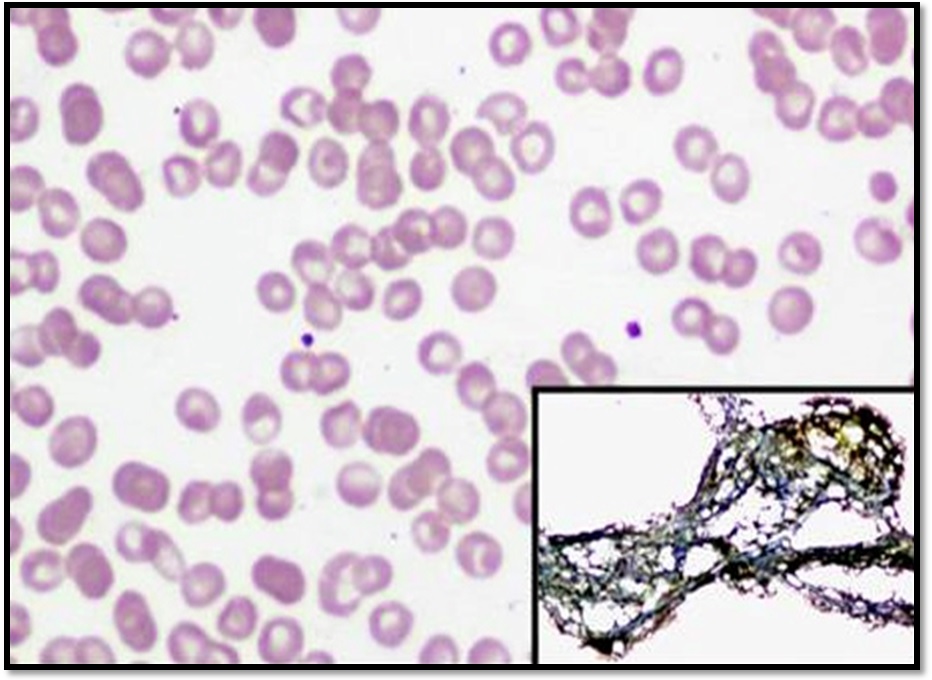Pancytopenia: A multidisciplinary assessment of hemato-etiological and clinical spectrum in a tertiary care hospital
Abstract
Background: The causes of pancytopenia range from simple, completely treatable diseases to serious life-threatening conditions. A thorough evaluation of these cases is mandatory as it would benefit the patients to receive appropriate treatment.
Objectives: Evaluation of etio-hematological and clinical spectrum of pancytopenia.
Settings and Design: A prospective study of two years (Jan 2016 -December 2017) was conducted on pancytopenic patients, attending Navodaya Medical College, Hospital and Research Centre, Raichur, Karnataka.
Material and Methods: Etio- hematological and clinical evaluation was done considering the relevant biochemical and serological investigations.
Results: A total number of 1368 cases were diagnosed as pancytopenia. The patients’ age ranged from 19 to 68 years and M: F ratio was 2.1:1. Most frequent clinical symptom was generalized weakness (90%) and least was bony pain (2%). Peripheral smear examination revealed predominantly macrocytic blood picture (47.9%). Bone marrow aspiration was performed in 444 cases (32.4%), among which Megaloblastic anaemia (Exclusive and Combined with iron deficiency anemia) was the commonest (52.7%). Etiologies of pancytopenia in decreasing order of frequency included Megaloblastic anemia {935 cases (68.4%) – Exclusive type (713 cases; 52.2%) and Combined with iron deficiency anemia (222 cases ;16.2%), followed by Dengue fever (141 cases ;10.3%), Hypoplastic/Aplastic anemia [106 cases ;7.8% (Drug induced - 4 cases; 0.2%)], Septicemia (60 cases ;4.5%), Leukemia (46 cases ;3.25%), Chronic malaria (46 cases ;3.25%) and Myelodysplastic syndrome (34 cases; 2.5%).
Conclusion: Keeping in mind varied etiologies of pancytopenia, thorough diagnostic evaluation is required to achieve better clinical outcome.
Downloads
References
2. Firkin F, Chesterman C, Penington D, Rush B. De Gruchy’s Clinical Hematology in Clinical Practice. 5th Edition. London Blackwell Scientific Publications 1989; 119-36.
3. Kumar et al. Pancytopenia - A 6 year study. J Assoc Physicians India 2001; 49: 1079-81.
4. Gayatri B N, Satyanarayan K. Pancytopenia –A clinico-haematological study. Journal of Laboratory physicians 2011; 3(1): 15-20.
5. Khodke K, Marwah S, Buxi G, Yadav RB, Chaturvedi. Bone marrow examination in cases of pancytopenia. J Academy Clin Med 2001; 2: 55-59.
6. Javalgi AP, Dombale VD. Clinico – Hematological Analysis of Pancytopenia: A Bone Marrow Study. National Journal of Laboratory Medicine Dec 2013; 2(4): 12-17.
7. Vaddatti T et al. Clinico-haematological profile of Pancytopenia- A South Indian tertiary hospital experience. Indian Journal of Pathology and Oncology July – September 2015; 2(3): 165-69.
8. Graham S, Marla NS, Fernandes H, Jayaprakash CS. A clinico-hematological evaluation of pancytopenia in a tertiary care hospital in South India. Muller Journal of Medical Sciences and Research Jan - Jun 2015; 6(1): 5-9.
9. Lakhey A, Talwar OP, Singh VK, KC Shiva Raj. Clinico-Hematological Study Of Pancytopenia. Journal of Pathology of Nepal 2012; 2(3): 207-10.
10. Khunger JM, Arculselvi S, Sharma U, Ranga S, Talib H. Pancytopenia- a clinico-haematological study of 200 cases. Indian J Pathol Microbiol 2002; 45(3): 375-79.[pubmed]
11..Reddy GPK, Kande V, Rao M. Clinical features and risk factors of pancytopenia: a study in a tertiary care hospital. International Journal of Advances in Medicine Feb 2016; 3(1): 68-72.
12. Shinwari S, Raziq F, Khan K, Uppal FT, Khan H. Pancytopenia: experience in a teriary care hospital of Peshawar, Pakistan. Rawal Medical Journal Oct-Dec 2012; 37(4): 370-73.
13. Barik SS, Chandoke RK, Verma AK. A prospective clinico‑hematological study in 100 cases of pancytopenia in capital city of India. Journal of Applied Hematology April-June 2014; 5(2): 45-50.
14. Tilak V, Jain R. Pancytopenia-A clinicohematological analysis of 77 cases. Indian J Pathol Mcrobiol 1992; 42(4): 339-404.[pubmed]
15. Verma Nidhi , Malik Harsh , Sharma Veena K, Agarwal Anil. Etiology of Pancytopenia in and around Meerut. Journal of Advance Researches In Biological Sciences 2012; 4(2): 145-51.
16. Mintzer DM, Billet SN & Chamielewski L. Drug induced Hematologic Syndromes. Advances in Hematology 2009; 1-11.[pubmed]



 OAI - Open Archives Initiative
OAI - Open Archives Initiative


